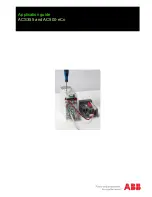
Page 64
FT
DX
9000D O
PERATION
M
ANUAL
U
SING
THE
µ-T
UNE
F
EATURE
The µ-Tune system is an advanced preselector for the RF front end of the Main (VFO-A) receiver, providing a much narrower
passband than the VRF circuit. The Q of the µ-Tune filter is so tight as to provide significant suppression of signals little more than
10 kHz away from your current operating frequency, and manual adjustment of the µ-Tune filter’s center frequency allows you to
position the shoulder of the filter in such a way as to enhance interference rejection to one side or another of your current frequency.
Because the insertion loss of the µ-Tune is somewhat higher than that of the VRF, we have also provided the capability to disengage
µ-Tune, and engage VRF, should your antenna and noise environment lead to system noise figure concerns when using µ-Tune.
The FT
DX
9000D’s Main (VFO-A) band receiver is equipped with µ-Tune modules covering the 1.8 ~ 14 MHz Amateur
bands. On the 18 ~ 50 MHz bands on the Main (VFO-A) receiver, and on all bands on the Sub (VFO-B) side, the VRF
circuit is provided.
µ-Tune Operation on the Main (VFO-A) Receiver
1.
Press the VRF/µ-T switch (#
). The imbedded
Red LED will light up.
The µ-Tune circuit will automatically align itself
onto your operating frequency.
Remember that µ-Tune only operates on the Main
(VFO-A) band on the 14 MHz and lower bands.
2.
Now rotate the VRF/µ-T knob (#
) to peak the
response (background noise) or reduce interference.
A pictorial representation of the tuning position
of the µ-Tune filter will appear on the bar graph
on the TFT.
The amount of change in the center frequency of
the µ-Tune filter, when rotating the VRF/µ-T
knob by one click, can be configured using Menu
item “GENERAL 035 µTUNE DIAL STEP.”
If you have performed manual adjustment of the
µ-Tune filter’s center frequency, you may press
and hold in the VRF/µ-T key for two seconds
to re-center the filter response on your current op-
erating frequency.
3.
Press the VRF/µ-T switch (momentarily) once more
to disengage the µ-Tune filter; the imbedded Red LED
will switch off. In this mode, only the fixed bandpass
filter for the current band will be engaged.
MAIN(VFO-A)
VRF/µ-T switch
MAIN(VFO-A)
VRF/µ-T knob
MAIN (VFO-A)
µ-Tune filter will appear
on the bar graph
µ-Tune filter will appear
on the bar graph
Quick Note
The permeability-tuning concept utilized in the µ-Tune cir-
cuit dates back many decades, as it was incorporated in
such classic transceivers as the FT-101 and FT-901 series,
in addition to the FT
DX
400 and similar models. The µ-
Tune circuit in the FT
DX
9000D is the highest develop-
ment of this circuit concept ever employed in an Amateur
transceiver.
Advice
The µ-Tune filters are the most advanced, selective RF preselector filters ever incorporated into an Amateur Radio
transceiver. The RF selectivity provided by µ-Tune can be of tremendous value in ensuring quiet, intermod-free recep-
tion even in the most crowded bands on a contest weekend. The µ-Tune filters provide RF selectivity on the order of a
few dozen kHz at -6 dB, at the expense of a few dB of system gain on bands where noise figure is seldom an issue. You
will notice that the S-meter deflection, when µ-Tune is engaged, is slightly less than when it is out of the circuit; this is
normal. If your antenna system gain is so low as to make it impossible to hear band noise when µ-Tune is engaged
(highly unlikely), just switch it out or revert to the VRF system, which has slightly less insertion loss.
As you tune around on an amateur band with µ-Tune engaged, the microprocessor automatically commands the stepper
motor driving the toroid core stack to center the filter on your current operating frequency. You may, however, use the
VRF/µ-T knob (#
) to skew the filter response to one side or the other from your operating frequency, to deal with
heavy interference on one side. To re-center the µ-Tune filter on your operating frequency, and eliminate any offset,
press and hold in the VRF/µ-T switch (#
) for two seconds.
A pictorial representation of the tuning position of the µ-Tune filter will appear on the bar graph on the TFT.
While µ-Tune is a superior RF preselection circuit, it may be disabled via the Menu; if this is done, the VRF circuit will
engage when the VRF/µ-T switch is pressed. To disable µ-Tune, go to Menu item “GENERAL 035 µTUNE DIAL
STEP” and set the selection to “OFF.”
The FT
DX
9000D includes an unmatched array of RF selectivity-enhancing features. Please study the material below
carefully, so as to understand the various features complete.
A
DVANCED
I
NTERFERENCE
-S
UPPRESSION
F
EATURES
: RF F
RONT
E
ND
Содержание FT DX 9000D - COMPUTER AIDED TRANSCEIVER
Страница 1: ...FTDX9000D Operation Manual...
Страница 2: ......
Страница 95: ...Page 93 FT DX 9000D OPERATION MANUAL NOTE...
Страница 101: ...Page 99 FT DX 9000D OPERATION MANUAL NOTE...
Страница 127: ...Page 125 FT DX 9000D OPERATION MANUAL NOTE...
Страница 149: ...Page 147 FTDX9000D OPERATION MANUAL NOTE...
Страница 152: ...Page 150 FTDX9000D OPERATION MANUAL NOTE...
Страница 153: ...Page 151 FTDX9000D OPERATION MANUAL NOTE...
Страница 154: ...Page 152 FTDX9000D OPERATION MANUAL NOTE...
















































